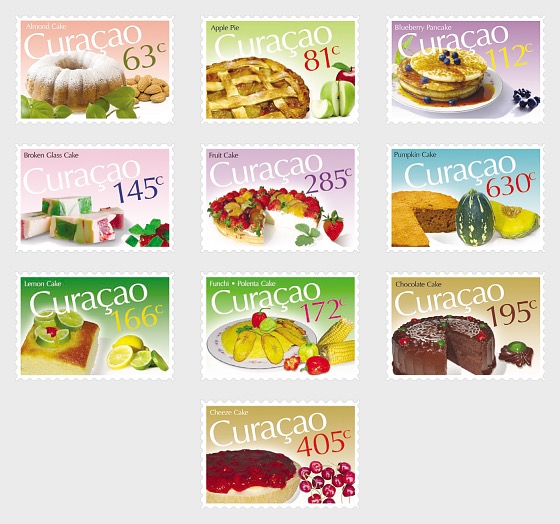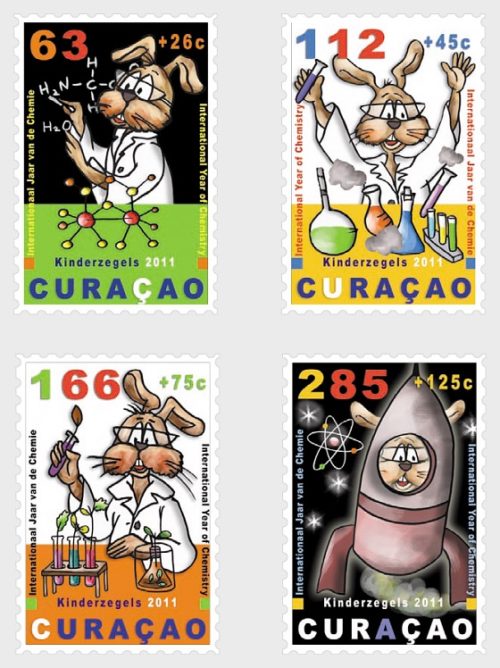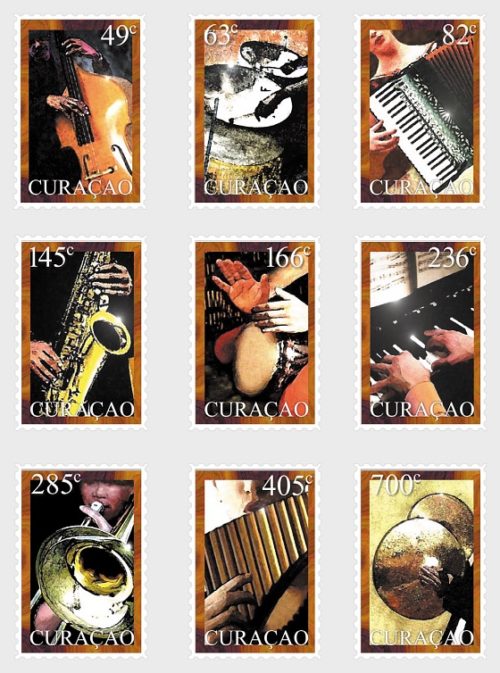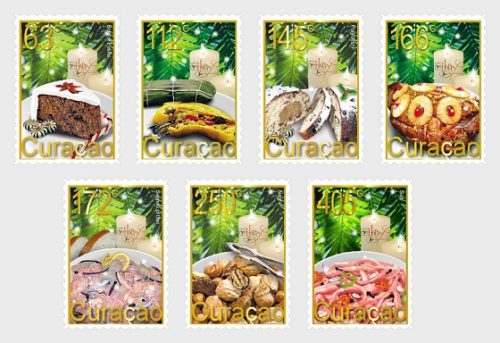Description
Cakes represents a very special food-item, that is served mostly during special occasions, family and friends gatherings, weddings, birthdays, graduations and anniversaries. In honor of those happy moments, Nieuwe Post is presenting an issue of 10 stamps of several kinds of cakes. The history of cakes date back to ancient times. The first cakes were very different from what we have today. . The first modern cakes (round ones with icing) were first baked in Europe in the mid-17th century.
Stamp 63 c Almond Cake
This moist-textured cake is best the day after it is made. Served with whipped cream or fruit, perhaps a berry compote it also goes perfectly with fruits & berries or chocolate frosting-an easy recipe for a classic cake.
Stamp 81 c Apple Pie An apple pie is a fruit pie (or tart) in which the principal filling ingredient is apples. In the nineteenth and twentieth centuries, apple pie became a symbol of American prosperity and national pride.
Stamp 112 c Blueberry Pancake
A pancake is a thin, flat, round cake prepared from a batter, and cooked on a hot griddle or frying pan. Most pancakes are quick breads; some use a yeast-raised or fermented. Archaeological evidence suggests that varieties of pancakes are probably the earliest and most widespread types of cereal food eaten in prehistoric societies.
Stamp 145 c Broken Glass Cake crown jewel cake
It’s not really a “cake” but a great colorful dessert. Its also called “Crown Jewel Cake” .This cake is based on a recipe that ran on the back of Jello boxes during the late 1950’s. Long gone are the days when Crown Jewel Cake (a.k.a. Broken Glass Cake) was made with powdered, processed, and if I may say – oldfangled – dream whip. The hydrogenated stuff has since been replaced with real cream, which makes it much tastier.
Stamp 166 c Lemon Cake
A Lemon Cake is sweet and buttery with a moist yet dense texture. This cake is similar to a pound cake and as its name implies, it has a tangy lemon flavor that comes from adding both lemon zest and lemon juice to the cake. The lemon flavor is also found in the lemon flavored frosting, made with confectioners sugar and lemon juice, that dries to a hard and crusty glaze. A lovely cake to serve in the afternoon with a hot cup of tea.Making friends and influencing people can usually be best achieved by sharing a slice of this moist and refreshing
Stamp 172 c Polenta Cake (Bola di Funchi)
Polenta is a type of flour, boiled cornmeal paste. Polenta looks like mash potatoes but yellowish generally heavy and hearty. In Curaçao main dishes such as fried fish, stewed goat, Okra and cactus are served with polenta cake, “funchi” in our native language. Polenta with beans and sugar becomes also one of our traditional, flavourfull and sweet side dish called “Tutu”.
Stamp 195 c Chocolate Cake
Chocolate cake is a cake flavored with melted chocolate or cocoa powder. . The history of chocolate cake goes back to 1764, when Dr. James Baker discovered how to make chocolate by grinding cocoa beans between two massive circular millstones. In 1828, Conrad Van Houten of the Netherlands developed a mechanical extraction method for extracting the fat from cacao liquor resulting in cacao butter and the partly defatted cacao, a compacted mass of solids that could be sold as it was “rock cacao” or ground into powder. Most popular variants of chocolate cakes are: Chocolate layer cake and – Black Forest cake and devils food –
Stamps 285 c Fruit Cake
In the 16th century, some goon discovered that fruit could be preserved by soaking it in successively greater concentrations of sugar, intensifying color and flavor. Having so much sugar-laced fruit engendered the need to dispose of it in some way—thus the fruitcake. By the early 19th century, the typical recipe was heavy as lead with citrus peel, pineapples, plums, dates, pears, nuts and cherries.The expression “nutty as a fruitcake” was coined in 1935.
Stamp 405 c Cheese Cake
Cheesecake is a dessert consisting of a topping made of soft, fresh cheese, usually on a crust or base made from biscuit, pastry or sponge cake. They may be baked or unbaked. Cheesecakes are frequently sweetened with sugar and may be flavored or topped with fruit, nuts, fruit sauce and/or chocolate. The earliest attested mention of a cheesecake is by the Greek physician Aegimus in 2000 BC. Later on in 1912, James Kraft invented a form of this cream cheese, but pasteurized it; this is now the most commonly used cheese for cheesecake. Cheesecake is a food rich in history, culture, tradition and ceremony. It is not the invention of a single person but a result of culinary evolution.
Stamp 630 c Pumpkin Cake
The name pumpkin originated from the Greek word for “large melon” which is “pepon.” “Pepon” was changed by the French into “pompon.” The English termed it “pumpion” or “pompion.” Pumpkin cake is very moist and delicious cake served during two of he more important American celebrations Halloween and thanksgiving.




